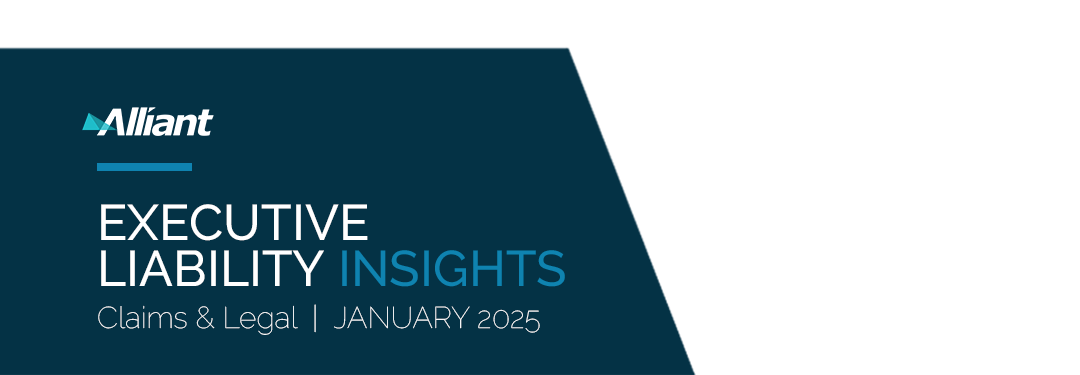
Navigating today’s complex risk environment can be a monumental task. Steve Shappell, Alliant Claims & Legal, spearheads Executive Liability Insights, a monthly review of news, legal developments and information on executive liability, cyber risk, employment practices liability, class action trends and more.


FEATURED ARTICLE
D&O POLICY’S RELATED WRONGFUL ACTS EXCLUSION BARS COVERAGE
Arch Ins. Co. v. PCH Mgmt. Alpha, LLC, 2024 Ill. App. Unpub. LEXIS 2381 (Ill. App. Ct., Dec. 9, 2024).
A court ruled that a D&O carrier had no duty to defend or indemnify its insured, a hospital management company, based on the policy’s interrelated wrongful acts exclusion (the “Exclusion). The insured was sued by a third-party medical holdings company and its managing member alleging that the insured had engaged in a fraudulent billing scheme with the company.
In This Issue:
FIFTH CIRCUIT’S DECISIONS MAY FURTHER DERAIL ESG INVESTING EFFORTS
Spence v. American Airlines Inc., et al, 4:23-cv-00552-O (N.D Tex., Jan. 10. 2025).
A Texas federal court ruled that a major airlines company (the “Company”) and its employee benefits committee (EBC) violated their fiduciary duty of loyalty under ERISA by prioritizing environmental, social and governance investment (“ESG”) goals over the financial interests of their employees. Notably, this suit was filed in the Northern District of Texas strategically.
Read More >>
DELAWARE COURT APPLIES NEW YORK LAW TO A COVERAGE DISPUTE ABOUT RELATEDNESS
Benefytt Techs., Inc. v. Capitol Specialty Ins. Corp., 2025 Del. Super. LEXIS 1 (Jan. 2, 2025).
A Delaware court, applying New York law, found coverage for a securities class action while denying coverage for a consumer class action on the grounds of insufficient/untimely notice of the latter to the Insurers.
Read More >>
NORTH CAROLINA SUPREME COURT FINDS PROPERTY INSURANCE POLICY COVERS LOSS OF PROPERTY USE DUE TO COVID RESTRICTIONS
N. State Deli, LLC v. Cincinnati Ins. Co., 2024 N.C. LEXIS 970 (N.C. Dec., 13, 2024).
The North Carolina Supreme Court ruled that “direct physical loss" within a property insurance policy encompasses the loss of the use of property due to COVID-19 public health orders. Several bars and restaurants had materially similar commercial property insurance policies issued by the same carrier.
Read More >>
NARROW INTERPRETATION OF WRONGFUL ACT DEFINITION IN PROFESSIONAL LIABILITY POLICY PRECLUDES COVERAGE FOR PROPERTY MANAGEMENT FIRM
Willow Bridge Prop. Co., LLC v. Arch Specialty Ins. Co., 3:24-CV-0029-D (N.D. Tex., Dec. 27, 2024).
A federal court held that a professional liability carrier did not have the duty to defend an insured in a class action lawsuit (the “Lawsuit”). The Lawsuit stemmed from a “nationwide conspiracy to fix and inflate the price of multifamily rental housing across the country,” in violation of federal and state antitrust laws, as the Lawsuit did not trigger coverage under the policy.
Read More >>
DELAWARE SUPERIOR COURT RULES “BUMP-UP PROVISION” DOES NOT APPLY TO BAR COVERAGE FOR SETTLEMENT OF SHAREHOLDER CLASS ACTION
Harman Int’l Industries, Inc. v. Illinois National Ins. Co. et al., No. N22C-05-098, (Del. Super. Ct. Jan. 3, 2025).
A Delaware court ruled that inadequate consideration was not a viable remedy for the claims brought by an audio electronics company (the “Company”), and that the settlement did not represent an increase in consideration.
Read More >>
CYBER CORNER
Click to read the following cases:
- DOES A BUSINESS HAVE STANDING TO SUE WHEN THEIR VENDOR GETS HACKED?
- FEDERAL COURT RULES WEBSITE TRACKING SUIT CAN PROCEED UNDER CALIFORNIA STATE WIRETAP LAW
- FINANCIAL INSTITUTIONS URGED TO DISCLOSE USAGE OF META PIXELS TO AVOID CLASS ACTION SUITS
Read More >>
EMPLOYMENT CORNER
Click to read the following cases:
- FIFTH CIRCUIT STRIKES DOWN NASDAQ BOARD DIVERSITY RULE
- INSURER’S DUTY TO DEFEND UNDER EPL POLICY NOT ELIMINATED BY INITIAL BREACH OF CONTRACT CLAIM
- U.S. SUPREME COURT UNANIMOUSLY REJECTS HEIGHTENED EVIDENTIARY STANDARD FOR PROVING THE APPLICABILITY OF FLSA EXEMPTIONS
- INSURER’S DENIAL OF COVERAGE BASED ON SEXUAL ABUSE AND MOLESTATION EXCLUSION IN INSURANCE POLICY UPHELD
Read More >>
SECURITIES CORNER
Click to read the following cases:
- INSURER’S DENIAL OF COVERAGE BASED ON SEXUAL ABUSE AND MOLESTATION EXCLUSION IN INSURANCE POLICY UPHELD
- ALLEGEDLY FALSE STATEMENTS IN SPAC DISCLOSURES COST THE COMPANY $6.75 MILLION
- DECEMBER 2024 NOTEWORTHY ENFORCEMENT ACTIONS FILED
- DECEMBER 2024 NOTEWORTHY SETTLEMENTS AND JUDGEMENTS
Read More >>
SHAREHOLDER CORNER
Click to read the following cases:
- DECEMBER 2024 SECURITIES CLASS ACTION FILINGS
Read More >>
D&O POLICY’S RELATED WRONGFUL ACTS EXCLUSION BARS COVERAGE
Arch Ins. Co. v. PCH Mgmt. Alpha, LLC, 2024 Ill. App. Unpub. LEXIS 2381 (Ill. App. Ct., Dec. 9, 2024).


A court ruled that a D&O carrier had no duty to defend or indemnify its insured, a hospital management company, based on the policy’s interrelated wrongful acts exclusion (the “Exclusion). The insured was sued by a third-party medical holdings company and its managing member, alleging that the insured had engaged in a fraudulent billing scheme with the company.
The insured subsequently sought coverage from its carrier for the underlying claim, which was denied based on the Exclusion. The carrier asserted that the claim triggered the Exclusion because it was interrelated with another claim brought by a hospital against the insured in a different lawsuit in a prior policy period. The carrier, however, argued the underlying action arose from, was based upon, or attributable to the same or interrelated wrongful acts as the prior lawsuit. In response, the insured argued that the claims were not interrelated because the parties, the contract, and the hospital where the events took place were different.
Both the underlying and prior lawsuit alleged that the insured supplied the hospitals with false projections and representations to fraudulently induce them to sign management agreements. The court determined that these allegations shared a common nexus of facts, circumstances, and events involving the insured insofar as the insured allegedly engaged in the same fraudulent billing scheme with both hospitals for its own financial benefit.
The court noted that what mattered "[was] the commonality between the course of action decided by [the insured] and implemented by its various wholly owned subsidiaries," and not whether "some of the entities involved in this common scheme are different." Ultimately, it was the scheme and not the players that determined whether the wrongful acts were related.
FIFTH CIRCUIT’S DECISIONS MAY FURTHER DERAIL ESG INVESTING EFFORTS
Spence v. American Airlines Inc., et al, 4:23-cv-00552-O (N.D Tex., Jan. 10. 2025).


A Texas federal court ruled that a major airlines company (the “Company”) and its employee benefits committee ("EBC") violated their fiduciary duty of loyalty under ERISA by prioritizing environmental, social and governance investment (“ESG”) goals over the financial interests of their employees. Notably, this suit was filed in the Northern District of Texas strategically. The forum’s popularity grew among the challengers of federal regulations, especially given that the appellate court remanded back to the district court a decision contesting the DOL’s ESG-friendly regulation.
The Fifth Circuit decision at issue here stemmed from a class action lawsuit filed by a former pilot on behalf of other employees (the “Class”). The Class alleged that the Company had mismanaged its 401(k) funds by allowing an investment manager to pursue ESG-focused agendas over the interests of the Class, thereby breaching the duties of prudence and loyalty.
According to the Class, the Company had breached is duty of prudence by failing to adequately monitor the funds such as review investment managers’ proxy voting. Specifically, the Class claimed that the Company failed to hire an investment adviser with adequate “care, skill, prudence, and diligence under the circumstances.” The Company, however, argued that at all times during the class period, its procedures surpassed those typically employed by similarly situated fiduciaries. The court agreed that the Company did not blindly rely on third parties to monitor the funds, but rather the Company “hired a well-qualified advisor” who provided extensive information regarding their investment strategies. Ultimately, the court held that the Company acted consistently with the prevailing industry standards and did not breach its duty of prudence.
In order to prevail on a breach of loyalty claim, the Class needed to demonstrate that a fiduciary’s decision was primarily motivated by interests beyond those of the Class. The Class argued that the Company breached their duty of loyalty when it failed to re-evaluate investments by its investment manager. During the class period it was known to the Company that the investment manager’s strategy shifted from core index portfolios to ESG funds, which underperformed traditional investments by about 10%.
Throughout the trial, the court concluded that Company allowed its corporate interests to outweigh the Class. The Class “proved by a preponderance of the evidence that [the Company] disloyally acted with an intent to benefit [themselves, as opposed to] the Plan participants and in a manner that was not wholly focused on the best financial benefit to the Plan.”
This ruling emphasizes the ongoing tension between ESG investment strategies, particularly in the Fifth Circuit, and the legal obligations of fiduciaries managing retirement plans.
DELAWARE COURT APPLIES NEW YORK LAW TO A COVERAGE DISPUTE ABOUT RELATEDNESS
Benefytt Techs., Inc. v. Capitol Specialty Ins. Corp., 2025 Del. Super. LEXIS 1 (Jan. 2, 2025).


A Delaware court, applying New York law, found coverage for a securities class action while denying coverage for a consumer class action on the grounds of insufficient/untimely notice of the latter to the Insurers.
At issue were two claims: one stemming from a securities class action lawsuit (the “Securities Action”) filed against the insured, a health insurance technology company (the “Company”) and certain individuals. The second claim arose from a consumer class action lawsuit (the “Consumer Action”) against the Company only, alleging RICO violations.
The Company sought coverage from its Insurers for both claims under its current policy term (the “Current Term”). Acknowledging coverage for the Securities Action, the Insurers determined the matter was interrelated to an earlier Notice of Circumstances tendered under the prior policy term (the “Prior Term”). Interpreting the specific policy language, the Insurers determined that the Securities Action and other actions submitted in connection with the Notice of Circumstances all involved the same or similar wrongful conduct. Thus, the Securities Action and the Notice of Circumstances shared a “common nexus” of facts. The Insured, in its pursuit of intact policy limits of the Current Term, disagreed.
The Insurers also denied coverage for the Consumer Action because it did not contain a nexus connecting it to the Notice of Circumstances. Therefore, because the stand-alone notice was sent to the Insurer only after the applicable policy expired, the Consumer Action was a claim made under an expired policy period.
Multi-million-dollar settlements followed and when the Insurers refused to pay for all Loss incurred, coverage litigation ensued. The Insured argued that the Securities Action was a standalone claim filed during the Current Term and not interrelated with the prior actions. In addition, the Company argued that the Consumer Action was “related to” the Securities Action and should have been covered under the Current Term (vitiating any issues of late notice).
The court agreed with the Insured and ruled that the Securities Action was covered under the Current Term and not interrelated with the earlier Notice of Circumstances. In applying New York law, the court employed a “side-by-side” review of other actions submitted as part of the Notice of Circumstances. The court reasoned that they required “numerous logically connected facts and circumstances” to be interrelated. In its detailed comparison between the earlier actions, the court reasoned that mere allegations of the Company’s misconduct under Securities laws in both actions were not a “sufficient factual nexus” to trigger the interrelated wrongful act definition under the policy.
In contrast, the court found that the Consumer Action was not covered under either policy because the initial complaint against the Company was excluded from coverage. The court declined to extend coverage to the amended complaint entity only, which added an individual defendant because the amended Consumer Action lacked a sufficient nexus of facts to conclude an interrelation with the Securities Claim.
NORTH CAROLINA SUPREME COURT FINDS PROPERTY INSURANCE POLICY COVERS LOSS OF PROPERTY USE DUE TO COVID RESTRICTIONS
N. State Deli, LLC v. Cincinnati Ins. Co., 2024 N.C. LEXIS 970 (N.C. Dec., 13, 2024).


The North Carolina Supreme Court ruled that “direct physical loss" within a property insurance policy encompasses the loss of the use of property due to COVID-19 public health orders.
Several bars and restaurants had materially similar commercial property insurance policies issued by the same carrier. The policies were "all-risk" policies protecting the restaurants’ buildings, personal property, as well as business income from any “direct physical loss” to property not excluded by the policy. The businesses sought coverage under those policies for loss sustained when they suspended business operations because of COVID-19 related orders. The issue was whether “direct physical loss,” which was not defined in the policies, occurred when government orders forced temporary restrictions on the use of and access to the restaurants’ physical property.
The carrier argued that the restaurants failed to establish that their businesses had to suspend operations because of a direct physical loss or damage to property. According to the carrier, the public health orders regulated the activity of people, while the restaurants' properties experienced no physical change. In turn, the restaurants argued that the orders resulted in a material deprivation of property by affecting how the property could be used, including whether and under what conditions the business premises could be open. The court found that the “loss” and “use” of property overlapped and there was a common-sense expectation that insurance would protect from threats to property that make it unusable for its intended purpose.
Ultimately, the court found that a reasonable policyholder in the restaurants’ shoes could expect “direct physical loss” to the property to include the results of the COVID-19-era orders which affected the restaurants’ ability to use their physical property.
NARROW INTERPRETATION OF WRONGFUL ACT DEFINITION IN PROFESSIONAL LIABILITY POLICY PRECLUDES COVERAGE FOR PROPERTY MANAGEMENT FIRM
Willow Bridge Prop. Co., LLC v. Arch Specialty Ins. Co., 3:24-CV-0029-D (N.D. Tex., Dec. 27, 2024).


A federal court held that a professional liability carrier did not have the duty to defend an insured in a class action lawsuit (the “Lawsuit”). The Lawsuit stemmed from a “nationwide conspiracy to fix and inflate the price of multifamily rental housing across the country,” in violation of federal and state antitrust laws, as the Lawsuit did not trigger coverage under the policy.
A property management company (the “Company”) purchased a Real Estate Developer Professional Liability policy from the insurance carrier (the “Carrier”), which provided that the Carrier would agree to pay for defense costs resulting from a “Claim first made against [the Company] during the policy period for a Wrongful Act . . . .” The Company timely tendered the Lawsuit to its Carrier, who subsequently denied coverage and defense obligations. Following the denial, the Company brought this action against the Carrier seeking damages and a declaration that the Carrier owed the Company a defense.
The Company argued that the policy defined “Wrongful Act” to include “Personal Injury” which was defined as “any actual or alleged: 1. False arrest, detention, imprisonment or malicious prosecution; 2. Wrongful entry or eviction; 3. Invasion of the right of privacy or 4. Libel, slander or other defamatory or disparaging material . . . .” Specifically, the Company argued that the underlying Lawsuit alleged intentional conduct—namely, deliberately fraudulent or criminal acts or omissions, willful violations of law, and illegal advantage—which fell within the definition of Wrongful Act. Thus, triggering the Carrier’s duty to defend.
The court disagreed with the Company and relied on the plain language in the policy. The court concluded that the policy’s coverage provision was only triggered by Claims that alleged either the negligent conduct specifically referenced in the Wrongful Act definition or the specific negligent and intentional conduct enumerated in the Personal Injury definition. The court held that the underlying Lawsuit did not allege conduct that potentially fell within the scope of the Policy’s coverage, and, thus, the Carrier did not owe a defense for the Lawsuit.
DELAWARE SUPERIOR COURT RULES “BUMP-UP PROVISION” DOES NOT APPLY TO BAR COVERAGE FOR SETTLEMENT OF SHAREHOLDER CLASS ACTION
Harman Int’l Industries, Inc. v. Illinois National Ins. Co. et al., No. N22C-05-098, (Del. Super. Ct. Jan. 3, 2025).


A Delaware court ruled that inadequate consideration was not a viable remedy for the claims brought by an audio electronics company (the “Company”), and that the settlement did not represent an increase in consideration.
In this matter, the insurers issued a D&O policy to the Company that was later involved in a “merger” with another company. Subsequently, a class action complaint was filed against the Company alleging violations of Sections 14(a) and 20 of the Securities Exchange Act of 1934. The shareholders alleged that the Company issued materially false and misleading statements to gain shareholder support for an “undervalued acquisition.” The shareholders further alleged that the Company was aware of and/or had access to the true facts indicating that the Company was more valuable than the amount received by shareholders in the acquisition. The shareholders sought “compensatory and/rescissory damages” against the Company.
The primary insurer denied coverage for any judgment or settlement based upon a “Bump-Up Provision” which stated:
In the event of a Claim alleging that the price or consideration paid or proposed to be paid for the acquisition or completion of the acquisition of all or substantially all the ownership interest in or assets of an entity is inadequate, Loss with respect to such Claim shall not include any amount of any judgment or settlement representing the amount by which such price or consideration is effectively increased; provided, however, that this paragraph shall not apply to Defense Costs or to any Non-Indemnifiable Loss in connection therewith.
Eventually, the class action settled for several million dollars. The Company then sued the insurers seeking coverage for the settlement amount.
The court divided the Bump Up Provision into prongs, all of which must be satisfied for the exclusionary language to apply: “(1) the settlement must be related to an underlying acquisition; (2) the inadequate price must be a viable remedy that was sought for at least one claim in the [underlying litigation]; and (3) the settlement, or a portion of the settlement, must represent an effective increase in consideration.”
The court agreed with the insurers that neither waiver nor estoppel was available to the Company. More specifically, the court noted that, as a general rule, a party cannot invoke estoppel to create coverage where none existed under the insurance contract. Additionally, the court ruled that based upon the facts of this case, the underlying transaction was an acquisition as required by the first prong of the Bump-Up Provision and not merely a merger.
However, the court ruled against the insurers with respect to the last two prongs of the Bump-Up Provision. First, the court ruled that damages for inadequate deal price is not a viable remedy under Section 14(a) and Section 20. While the relief sought by the shareholders—the difference between the price shareholders received and the Company’s true value at the time of the acquisition—may sound like a request for inadequate consideration, the court noted that the claim was not based upon a failure to negotiate a better deal. Instead, the shareholders claims were based upon alleged misrepresentations concerning the value of the Company.
Second, the court ruled that the settlement did not represent an effective increase in consideration. The court stated that it “could not find that any part of the [settlement] represents an amount by which the transaction price or consideration is effectively increased.” The settlement amount was within the estimated range of defense costs. Finally, the court noted that the class included shareholders that sold their shares prior to receiving any deal consideration and, thus, were only indirectly impacted by the alleged inadequate consideration.
Cyber Corner
DOES A BUSINESS HAVE STANDING TO SUE WHEN THEIR VENDOR GETS HACKED?
In re MOVEit Customer Data Sec. Breach Litig., 2024 U.S. Dist. LEXIS 224712 (D. Mass., Dec. 12, 2024).
A district court held that the parties affected by a cyberattack on the software of a software developer (the “Company”) had “standing” (or, in other words, demonstrated a concrete, traceable, and redressable injury) to sue in court.
FEDERAL COURT RULES WEBSITE TRACKING SUIT CAN PROCEED UNDER CALIFORNIA STATE WIRETAP LAW
Rebeka Rodriguez v. Autotrader.com,. 2:24-cv-08735 (C.D. Cal., Jan. 13, 2025).
A federal judge refused to dismiss a proposed class action against an online automobile exchange (the “Company”) for allegedly sharing the search inquiries of visitors to its website with third parties in violation of the state’s wiretap law.
FINANCIAL INSTITUTIONS URGED TO DISCLOSE USAGE OF META PIXELS TO AVOID CLASS ACTION SUITS
In recent years, healthcare providers have been hit with an avalanche of “Meta Pixel” class action lawsuits, alleging that the use of website tracking technology violates state and federal privacy laws as well as various consumer protection laws. Recently, however, there has been a shift in these suits, now targeting financial institutions.
Employment Corner
FIFTH CIRCUIT STRIKES DOWN NASDAQ BOARD DIVERSITY RULE
Alliance for Fair Board Recruitment v. SEC, No. 21-60626 (5th Cir., Dec. 11, 2024).
The Fifth Circuit Court of Appeals struck down a rule proposed by the National Association of Securities Dealers Automatic Quotation System (“Nasdaq”), which is one of the world’s largest stock exchanges. Nasdaq’s proposed rule sought to require Nasdaq-listed companies to maintain at least two diverse board directors or explain its failure to do so. The rule would also require these companies to make other board-diversity related disclosures.
INSURER’S DUTY TO DEFEND UNDER EPL POLICY NOT ELIMINATED BY INITIAL BREACH OF CONTRACT CLAIM
Clearpoint Fed. Bank & Trust v. Fed. Ins. Co., (Ind. Ct. App. Jan. 15, 2025).
A court found an Insurer had a duty to defend an Insured under an EPL policy, despite an employment contract exclusion, due to other potentially covered claims in the underlying lawsuit (the “Lawsuit”). The Lawsuit was brought by a former CEO against the Insured, a community bank and trust (the “Bank”), and its board chair (“Chair”).
U.S. SUPREME COURT UNANIMOUSLY REJECTS HEIGHTENED EVIDENTIARY STANDARD FOR PROVING THE APPLICABILITY OF FLSA EXEMPTIONS
E.M.D. Sales, Inc. v. Carrera, 604 U.S. _____ (2025).
In a unanimous 9-0 ruling, the U.S. Supreme Court resolved a circuit split holding that an employer only needs to prove FLSA exemptions by a preponderance of the evidence rather than by the higher clear and convincing evidentiary standard.
INSURER’S DENIAL OF COVERAGE BASED ON SEXUAL ABUSE AND MOLESTATION EXCLUSION IN INSURANCE POLICY UPHELD
Knaack v. Allied World Specialty Ins. Co., 2024 U.S. Dist. LEXIS 234213 (W.D. Wash., Dec 30, 2024).
A federal court held that an Insurer was not responsible for defending an Insured in a lawsuit filed for sexual misconduct under its management liability policy due to the policy’s exclusion targeting sexual abuse and sexual molestation claims.
Securities Corner
NEW YEAR AND NEW RULES – SEC APPROVES REPORTING REQUIREMENTS FOR COVERED SECURITIES LOANS
The SEC started 2025 by announcing a new set of rules for covered securities loans, requiring persons entering into securities loans, as well as their intermediaries (such as reporting agents) to report the loans’ terms to the Financial Industry Regulatory Authority (“FINRA”). FINRA proposed the adoption of the new Rule 6500 Series for the implementation of the Securities Lending and Transparency Engine (“SLATE”).
ALLEGEDLY FALSE STATEMENTS IN SPAC DISCLOSURES COST THE COMPANY $6.75 MILLION
A global financial services company (the “Company”) reached a settlement with the SEC, agreeing to pay a $6.75 million penalty without admitting or denying its liability for the underlying claims. The underlying claims centered around allegations that two of the Company’s special purpose acquisition companies (the “SPACs”) made misleading statements in advance of the initial public offerings (“IPOs”).
|
Director/Officer |
Role |
Company |
|
Stephen K. Leech |
Co-CIO |
Western Asset Management Company LLC |
|
Maurizio Chiriva-Internati |
CEO |
Kiromic BioPharma, Inc. |
|
Steve A. Smith Jr. |
CEO |
Xtreme Fighting Championships, Inc. |
|
Frederick T. Dencer & Luke A. Dencer |
Founders |
Standard Holdings, Inc. & Standard Huaxia, Ltd. |
|
Ken Peterman |
Former CEO |
Comtech Telecommunications Corp. |
|
Donald T. Netter |
Director |
Dolphin Associates III, LLC |
|
Cameron Durrant & Dale D. Chappell |
CEO CSO |
Humanigen, Inc. |
|
Director/Officer |
Role |
Company |
|
Stephen K. Leech |
Co-CIO |
Western Asset Management Company LLC |
|
Maurizio Chiriva- Internati |
CEO |
Kiromic BioPharma, Inc. |
|
Steve A. Smith Jr. |
CEO |
Xtreme Fighting Championship, Inc. |
|
Frederick T. Dencer & Luke A. Dencer |
Founder |
Standard Holding, Inc. & Standard Huaxia, Ltd. |
DECEMBER 2024 NOTEWORTHY SETTLEMENTS AND JUDGMENTS
|
Amount |
Director/Officer |
Role |
Company |
|
$603,918.85 |
Richard D. Rockwell |
Founder |
Dow Rockwell LLC |
|
$12,918,281 |
Guosheng Qi |
CEO |
Gridsum Holding, Inc. |
|
$260,000 |
Rosiland Brooks-Harris |
Former Director |
City of Rochester, NY |
|
Amount |
Director/Officer |
Role |
Company |
|
$603,918.85 |
Richard D. Rockwell |
Founder |
Dow Rockwell LLC |
|
$12,918,281 |
Guosheng Qi |
CEO |
Gridsum Holding, Inc. |
|
$260,000 |
Rosiland Brooks- Harris |
Former Director |
Humanigen, Inc. |
Source: U.S. Securities and Exchange Commission
https://www.sec.gov/litigation/admin.htm
Source: Stanford Law School Securities Class Action Clearinghouse
ABOUT ALLIANT INSURANCE SERVICES
Alliant Insurance Services is the nation’s leading specialty broker. In the face of increasing complexity, our approach is simple: hire the best people and invest extensively in the industries and clients we serve. We operate through national platforms to all specialties. We draw upon our resources from across the country, regardless of where the resource is located.
Contributors


Abbe Darr, Esq.
Claims Attorney
abbe.darr@alliant.com
Chuck Madden, Esq.
Claims Attorney
chuck.madden@alliant.com
David Finz, Esq.
Claims Attorney
david.finz@alliant.com
Isabel Arustamyan, Esq.
Claims Attorney
isabel.arustamyan@alliant.com
Jacqueline Vinar, Esq.
Claims Attorney
jacqueline.vinar@alliant.com
Jaimi Berliner, Esq.
Claims Attorney
jaimi.berliner@alliant.com
Karina Montoya, J.D.
Claims Advocate
karina.montoya@alliant.com
Malia Shappell, Esq.
Claims Attorney
malia.shappell@alliant.com
Michael Radak, Esq.
Claims Attorney
michael.radak@alliant.com
Naomi Egwakhide Oghuma, J.D.
Claims Advocate
naomi.egwakhideoghuma@alliant.com
Peter Kelly, Esq.
Claims Attorney
peter.kelly@alliant.com
Robert Aratingi
Senior Claims Advocate
robert.aratingi@alliant.com
Steve Levine, Esq.
Claims Attorney
slevine@alliant.com